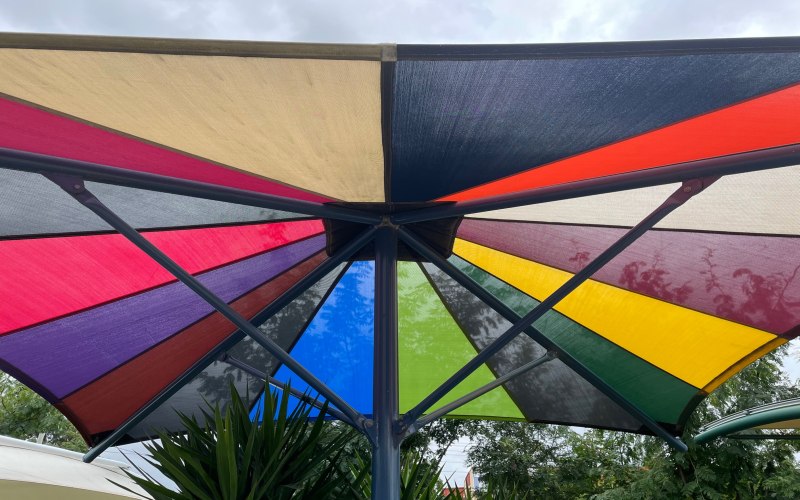Lets take a close look at Shadecloth and Shade Sails
Does shadecloth hold water?
A shadecloth is an open weave mesh. Shadecloth is not waterproof.
Water flows through shadecloth like a mist. Water may sit on the shadecloth surface temporarily in heavy rain for 2 reasons: the lag between rain amount and speed that water will flow through the mesh, and surface tension, where water molecules adhere to the mesh for a short time.
Water will tend to flow over shadecloth readily if sides have a fall. As sides become steeper more water will flow over the shadecloth and less water will go through the shadecloth.
Does Australia manufacture Shadecloth
Yes. Shadecloth has been made in Brisbane Australia for decades. It is amongst the strongest shadecloth available anywhere. The shadecloth brand Monotec 370 suits our climate and has withstood the test of time over 25 years as a commercial grade shadecloth. At Abacus Shade Structures we offer Australian made shadecloth to all clients.
Does a shadecloth sail need to be re-tensioned after installation?
No. A shadecloth sail once installed should remain in place and not change shape. Tension should firm to make the sail tight. A well designed and tensioned sail will withstand typical regional wind loads and not stretch with day-to-day wind movement. A stretched and flapping shade sail is not attractive and is not desirable as it will not disperse wind effectively. A stretchy shadecloth which does not retain its original shape after installation may indicate a poor quality fabric. Good quality shadecloth and good design go hand in hand to give a taut shade sail for many years.
Legitimate distortion may occur following extreme storms or hail events. In such cases insurance may be considered to replace the damaged sail.
Should turnbuckles be used in shadecloth sails?
Turnbuckles are not necessary. A shade sail should be installed close to its wall or post connection to provide maximum shade coverage. Turnbuckles reduce total surface area of the sail which is not desirable.
A single turnbuckle should only be in DIY projects to help tension a sail as tensioning options may be limited. Sails should be drum tight.
Why does my sail have curves in it?
Most shade sails typically have curved edges. It’s the only way tension can be achieved between connection points when there is no frame. Steel cable used in the edge will straighten the curve somewhat as the cable is tensioned. This leads to a tensioning of the sail and a classic design characteristic of shade sails. Curves range from 5-10% of the length of that side.
Straight sided sails are also possible. A straight edge needs to be connected to a straight frame which can be added into the project. On Abacus Shade Structures installations, a preliminary drawing is supplied before construction commences. This drawing indicates straight or curved edges.
Is shadecloth non-combustible?
Shadecloth is fire retardant, it is not non-combustible. No textile in Australia is non-combustible. Australian and International Standards specify test criteria for shadecloth to ensure it is safe and fit for its intended purpose. Shadecloth used in Australia is tested to AS1530 Parts 2 &3 which specifically uses a fixed flame in contact with the fabric and measures radiant heat in close proximity to a fabric. The tests determine Flammability, Ignition and Spread of Flame and Smoke developed index ranges. The Rural Fire Services applies this rating index to assess which shadecloth is suitable.
Can shadecloth offer high UV effectiveness?
There is well established evidence that exposure to ultraviolet radiation (UVR) from the sun can lead to skin cancer. Shadecloth does offer high UV effectiveness.
Acceptable Shadecloth UV protection ratings for “People Protection” categorise Ultraviolet effectiveness from a range of not effective , effective to very effective in AS4174. Australian Standard AS4174 2018 sets the specifications for shadecloth fabric manufacture.
Seeking shade under a shade structure or shade sail is one of the sun protection measure which when used in combination of other protective measures provides excellent UV protection.
What affects UV levels in shade sails?
There are many factors that contribute to the ultimate UV effectiveness levels of a shade sail. These include
- Weave density of the shadecloth,
- Closeness of buildings and trees to the sail which cast shade onto the sail,
- Sun movement near the sail which changes throughout the day and the seasons,
- Reflection from nearby surfaces which can bounce UV
- Distance of people from the shade sail and
- Design of the shade sail which can take all these considerations into account to maximise shade.
Australian Standard AS4178 2018 stipulates that ultimate UV effectiveness levels in shadecloth for People Protection are influenced by factors in addition to direct UV levels of the shadecloth.
How is performance measured in shadecloth.
Performance and strength are measured under AS2001. Tests conducted include break strength, bursting strength, tear strength. Performance is a desirable attribute for optimum performance and longevity for all shade sails. The length of warranties on shadecloth are directly based on such performance indicators. UV Protection as measured by AS4174 does no test for strength and performance. They are totally different characteristics and measured by different tests and Australian Standards. Each standard has its own merit.

